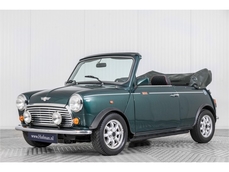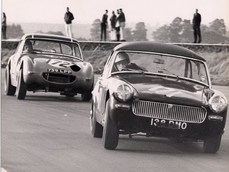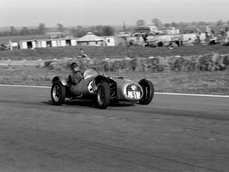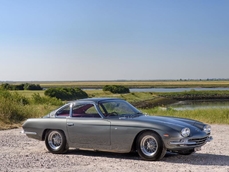Mini Cooper GTS Works Race Car 1966
General description :
Woodham Mortimer are delighted to offer one of the most iconic Mini Cooper S cars from the 1960’s; the only Factory Works Broadspeed GTS Race Car, originally registered EOP 88D.
The brainchild of Ralph Broad, the Birmingham-born saloon car racer and tuner and produced by his company Broadspeed Engineering. Broad’s career in the automotive industry began at the early age of 14 when he took over the family garage business after the death of his father. Broad was a confident man with a zest for life so it is unsurprising that he took up racing and was one of the pioneers who first saw the competition potential in the new BMC Mini, securing a class win in his maiden Silverstone race with a Mini in 1959. His lap times were fast enough to comprehensively demolish the class lap record and the publicity value of such performance was not lost on Broad who soon offered private Mini customers a full race conversion for £340.
Building on these early successes he established Team Broadspeed in 1962, competing against the factory-backed Mini Coopers in Group 3 of the British Touring Car Championship. While the Broadspeed cars sometimes lacked the straight-line speed of the works cars, their overall handling was deemed superior and as they became more competitive they were able to attract BMC factory support in 1964. By 1965, Broadspeed became the official works team for the BMC Mini Cooper S in the European Saloon Car Championship. The Broadspeed cars won their class at the Monza 4 Hours, Spa and Zandvoort, but despite this success, Broad moved to Ford at the end of 1965 to run a team of Ford Anglias, taking his top driver, John Fitzpatrick, with him for the 1966 season.
While running his team of Broadspeed Anglias, Broad had also gone into small-scale road car production with his Mini Cooper-based Broadspeed GT 2+2. This incredible little car not only looked very different from its Mini parent but featured numerous interior improvements and performance modifications. The most notable difference in its exterior looks from a standard Mini was the new streamlined fibre-glass fastback roof and rear spoiler. Other changes were dependent on the model chosen: for a road car there was the entry level GT, which featured the bodywork changes plus adjustable suspension and steering column; the GT de-luxe which had special seats, thicker carpets, new dash panel and moulded bumpers; and finally the top of the range Super de-luxe which had everything else plus twin fuel tanks, improved lighting, leather covered steering wheel, “Paddy Hopkirk” throttle pedal extension, highly tuned engine, oil-cooler, twin exhausts and competition brakes. The engine tune was particularly noteworthy and involved a modified cylinder head, Broadspeed “Road/Race” camshaft, re-contoured combustion chambers, a 10.5 to 1 compression ratio and a modified inlet manifold carrying two 1 ½ inch H4 S.U.s. .
In addition to the road car there was also a very special GTS racer (this car), which contemporary reports estimated to be capable of 140 mph. This variant was stripped out and significantly lighter than the road going versions and featured lightweight mag-alloy wheels, competition dynamo, undertray, lightweight doors and bonnet, lightened chassis, strengthened sub-frames, fully adjustable front and rear suspension and a fully tuned 1,366cc engine. From the outset the numbers of GTS cars built was to be extremely limited and only available to special customers. In the end only one example was built by Broadspeed as a works racer to be driven by John Fitzpatrick.
The resulting GT and GTS Mini coupe had the appeal of a small-scale Aston Martin and was warmly received with public and press alike. Sadly the production run was curtailed and by the time the factory closed in 1968 (demolished to make way for a ring road) only 28 had been built.
The example offered here is the only works GTS race car built. The race car was campaigned extensively by John Fitzpatrick for Broadspeed, who scored numerous class wins and podium finishes over the 1966 and 1967 seasons at venues as varied as Brands Hatch, Oulton Park, Zandvort and Welschap.
Professionally restored in recent years, this is possibly a once in lifetime opportunity acquire one of the most important Mini derivatives of the 1960s.
Please contact us for further details. UNDER OFFER
https://www.jdclassics.com/Cars/For-Sale/1966-Broadspeed-Mini-GTS-Works-Race-Car/834a6f34-d877-4a67-f576-08d526a380ce
1966 Mini Cooper GTS Works Race Car is listed sold on ClassicDigest in Mayfair by JD Classics for Not priced.
Car Facts
Car type : Car Make : Mini Model : Cooper Model Version : GTS Works Race Car Engine size : 0.0 Model Year : 1966 Location : Maldon
Sold
Seller Information
Sold
People who viewed this Mini Cooper also viewed similar Mini listed at ClassicDigest
Other cars listed for sale by this dealer
About Mini
The Mini is indeed an iconic car that revolutionized the automotive industry and set the standard for compact cars. Here's a brief history of the Mini, its development, and some of the key versions of the classic Mini:1. Origins and Development:
Founder and Designer: The Mini was designed by Sir Alec Issigonis, a British-Greek automotive engineer.
Introduction: The Mini was officially introduced by the British Motor Corporation (BMC) in 1959.
Innovative Design: Issigonis' design featured a transverse engine, front-wheel drive, and a compact layout, maximizing interior space.
2. Classic Mini Models:
Mark I (1959–1967):
Mini Cooper (1961): The performance-oriented Cooper version, developed in collaboration with racing legend John Cooper, was introduced.
Mark II (1967–1970):
Minor design changes, including a redesigned grille.
Mark III (1969–2000):
Introduction of the Clubman and Clubman Estate variants.
Further design updates, including a more rounded front grille.
3. Mini Cooper S:
Performance Variant: The Mini Cooper S, particularly the Mk I version, became famous for its success in rally racing, winning the Monte Carlo Rally multiple times.
4. Mini Moke:
Utility Vehicle: The Mini Moke was a utility vehicle based on the Mini platform, featuring an open-top design. It gained popularity in various warm-weather locations.
5. Mini Countryman:
Extended Version: The Mini Countryman was introduced as a longer and more practical version of the classic Mini. It featured a rear-hinged door for easier access to the rear seats.
6. End of Production:
Later Years: Production of the classic Mini continued until the year 2000.
Final Editions: The last classic Mini rolled off the production line on October 4, 2000, marking the end of an era.
7. BMW Era and New MINI:
BMW Acquisition: BMW acquired the rights to the Mini brand and introduced the new MINI in 2001.
Modern Interpretation: The new MINI retained some design cues from the classic but featured modern technology and safety standards.
8. Legacy and Influence:
Cultural Icon: The classic Mini became a cultural icon, symbolizing British design and efficiency.
Influence on Compact Cars: The Mini's layout and design principles influenced the development of compact cars for decades to come.
The Mini's impact on the automotive industry goes beyond its compact size; it represents a design philosophy that prioritizes efficiency, space utilization, and a fun driving experience. The classic Mini's enduring popularity is a testament to its timeless design and innovative engineering.











